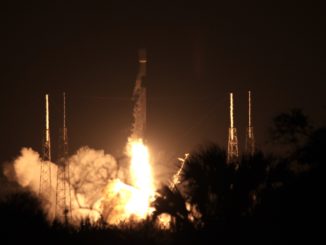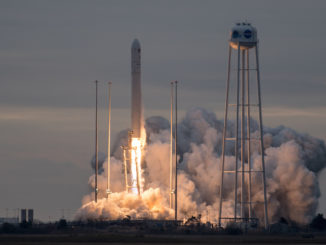Updated after test completion.

Sierra Nevada Corp. conducted a captive carry test flight of the Dream Chaser spaceplane Wednesday at NASA’s Armstrong Flight Research in California.
About one-quarter the length of a space shuttle orbiter, the Dream Chaser is being developed to ferry cargo to and from the International Space Station. After blasting off on top of an Atlas 5 rocket, the ship will return to land on a runway.
The automated spacecraft was lifted airborne Wednesday by a dual-rotor Boeing Vertol 234 helicopter operated by Columbia Helicopters. The “captive carry” test flight was expected to be used to test out telemetry and control systems before a planned drop test later this year to demonstrate Dream Chaser’s ability to make an autopilot approach and landing to a runway.
The captive carry test comes after a series of tow tests at NASA’s Armstrong facility, co-located at Edwards Air Force Base in California’s Mojave Desert.
Sierra Nevada plans the first orbital flight of Dream Chaser to the space station in 2020.
Suspended under a 200-foot lift line, the 30-foot-long (9-meter) test craft flew around the dry lake bed at Edwards Air Force Base, making several high-speed and high-altitude passes to test out the ship’s aerodynamics and simulate the conditions needed during the approach and landing demonstration later this year.
“On-board the vehicle, we have all the orbital vehicle avionics,” said Steve Lindsey, senior director and co-program manager for Sierra Nevada’s space exploration systems division. “The avionics on-board are identical to what we will have on the orbital vehicle, as well as the flight software for the orbital vehicle.
“That’s why (this test) is so critical to us,” said Lindsey, a former space shuttle commander. “It will test that. It will also test the aerodynamics of the vehicle. We flew it once before and know kind of how it flies, but we’re going to test that again and get additional aerodynamic data.”

Sierra Nevada webcast the start of the test live, but the company ended the video stream shortly after takeoff. The vehicle made a safe landing after about an hour-and-a-half airborne.
“We are very pleased with results from the captive carry test, and everything we have seen points to a successful test with useful data for the next round of testing,” said Lee Archambault, a former astronaut and Sierra Nevada’s director of flight operations for the Dream Chaser program.
The current testing in California comes four years after Sierra Nevada conducted similar flight tests when the company aimed to fly Dream Chaser with astronauts on-board. The Dream Chaser test vehicle made an on-target approach to a runway after letting go from its helicopter carrier, but one of the craft’s main landing gear failed to deploy, leading the spaceplane to spin out of control after touchdown.
Sierra Nevada says the 2013 flight was successful until that point, and Dream Chaser’s autopilot landing system steered the craft toward the runway for a touchdown on the centerline.
Engineers blamed the mishap on a landing gear borrowed from a U.S. Air Force F-5E jet. Future Dream Chaser cargo missions to the space station will fly with a different landing gear, and the refurbished spaceship now in California features a gear more advanced then the one at fault in 2013.
Engineers also upgraded the ship’s computer systems to be more like the orbital version of the Dream Chaser.
At least one more captive carry test is planned before the free flight, which Lindsey said must be conducted in cooler weather than the scorching temperatures Wednesday in the Mojave Desert. The carrier helicopter’s lift capability is limited by hot temperatures.
Sierra Nevada also plans a release test using airbags before the Dream Chaser’s approach and landing flight to check out the drop mechanism.
Email the author.
Follow Stephen Clark on Twitter: @StephenClark1.



